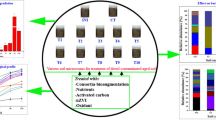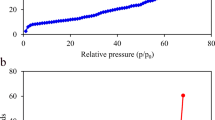Abstract
Pollution caused by spent engine oil has become a major global ecological concern as it constitutes a big threat to plants, animals, microorganisms and the soil ecosystem. This study was undertaken to examine the remediation of spent engine oil-contaminated soil through biostimulation and bioaugmentation with sodium dodecyl sulphate and indigenous hydrocarbonoclastic bacterial isolates. Twelve mesocosms were organized into four groups designated G1, G2, G3 and G4 and each filled with 2.5 kg of soil samples. Each group was composed of three mesocosms to produce a triplicate setup. G1 contained pristine soil which served as a positive control. G2 contained a total petroleum hydrocarbon (TPH) of 913.333 mg/kg in the untreated oil-polluted soil which served as a negative control. G3 contained a TPH of 913.333 mg/kg in the polluted soil inoculated with indigenous hydrocarbonoclastic bacterial isolates. G4 contained a TPH of 913.333 mg/kg in the polluted soil mixed with bacterial consortium and sodium dodecyl sulphate. The level of pollution was 36.5% in the triplicate setup G2, G3 and G4. Fourier Transform Infrared spectroscopy was used to determine the degree of hydrocarbon degradation. The initial TPH value of 913.33 mg/kg was reduced by 84.44% (142 mg/kg) in soil inoculated with indigenous hydrocarbonoclastic bacterial isolates and by 88.28% (106.66 mg/kg) in biostimulated soil. Result of this study show that soil stimulation involving bacterial consortium and sodium dodecyl sulphate was more efficient than bioaugmentation strategy alone used in the remediation of spent engine oil-polluted soil.








Similar content being viewed by others
Data availability
The datasets generated during and/or analysed during the current study are available from the corresponding author on reasonable request.
References
Abioye OP, Agamuthu P, Abdulaziz AR (2012) Biodegradation of used motor oil in soil using organic waste as amendments. Biotechnol Res Int. https://doi.org/10.1155/2012/587041
Adedokun OM, Ataga AE (2007) Effect of amendment and bioaugmentation of soil polluted with crude oil, automotive gasoline oil, and spent engine oil on the growth of cowpea (Vigna unguiculata L. Walp). Sci Res Essay 2(5):1147–1149
Adeleye AO, Nkereuwem ME, Omokuhudu GI, Amoo AO, Shiaka GP, Yerima MB (2018) Effect of microorganisms in the bioremediation of spent engine oil and petroleum related environmental pollution. J Appl Sci Environ Manag 22(2):157–167
American Public Health Association (1998) Standard methods for the examination of water and waste water, 20th edn. American Public Health Association, Washington, p 1134
Arostein BN, Alexander M (1992) Surfactants at low concentrations stimulate biodegradation of sorbed hydrocarbons in samples of acquifer sands and slurries. Environ Toxicol Chem 11:1227–1233
Asiama JY, Otwe EP, Danquash A, Apori SO, Hanyabui SO (2021) Effect of spill spent engine oil quality indicators and physiological performance of maize, cowpea, and sorghum. Afr J Environ Sci Technol 15(7):262–269
Bates RA (1954) Electrometric determination. John Wiley and Sons, Inc., New
Bezza FA (2016) Biosurfactant assisted bioremediation of petroleum and polycyclic aromatic hydrocarbons in aquatic and soil media. University of Pretoria (Doctoral Dissertation) 10–28:28–34
Braddock JF, Ruth ML, Caterall PH, Walworth JL, McCarthy KA (1997) Enhancement and inhibition of microbial activity in hydrocarbon contaminated arctic soils: implications for nutrient amended bioremediation. Environ Sci Technol 31(7):2078–2084
Bushnell LD, Haas HF (1941) The utilization of certain hydrocarbons by microorganisms. J Bacteriol 41(5):653–673
Bustamante M, Durán N, Diez MC (2012) Biosurfactants are useful tools for the bioremediation of contaminated soil: a review. J Soil Sci Plant Nut 12(4):667–687
Carrillo P, Mardaraz C, Pitta-Alvarez S, Guilleti A (1996) Isolation and selection of biosurfactant producing bacteria. World J Microbiol Biotechnol 12:82–84
Chen B, Ye X, Zhang B, **g L, Lee K (2019) Marine oil spills-preparedness and countermeasures in world seas: an environmental evaluation, 2nd edn. Academic press, London, pp 407–426
Coates J (2000) Interpretation of infrared spectra a practical approach. Encycl Anal Chem 12:10815–10837
Deschernes L, Lafrance P, Villeneuve JP, Sampson R (1996) Adding sodium dodecyl sulfate and Pseudomonas aeruginosa UG2 biosurfactants inhibits polycyclic aromatic hydrocarbon degradation in a weathered creosote-contaminated soil. Appl Microbiol Biotechnol 45:638–646
Duffus JH (2002) Heavy metals “a meaningless term’’ (IUPAC technical report). Pure Appl Chem 74:793–807
Elliot R, Singhal N, Swift S (2010) Surfactants and bacterial bioremediation of polycyclic aromati hydrocarbon contaminated soil—unlocking the targets. Crit Rev Environ Sci Technol 41(1):78–124
Eze CN, Orjiakor PI (2020) Evaluation of the effects of bioaugmetation and biostimulation on the vegetative growth of Zea mays grown in crude oil contaminated sandy soil. J Mater Environ Sci 11(5):695–703
Irwin RJ, Van-Mouwerik M, Stevens L, Seese MD, Basham W (1997) Environmental Contaminants Encyclopedia. National Park Service, Water Resources Division, Fort Collins, Colorado. Available at https://www.nature.nps.gov/water/ecencyclopedia/index.cfm. (Accessed on 10th Nov 2020)
Jain D, Collins-Thompson D, Lee H (1991) A drop collapsing test for screening surfactant-producing microorganisms. J Microbiol Methods 13(4):271–279
Margenot AJ, Calderon FJ, Goyne KW, Mukome FND, Parikh SJ (2017) IR spectroscopy soil analysis application. In: Lindon JC, Koppnaal DW (eds) The encyclopaedia of spectroscopy and spectrometry, 3rd edn. Oxford Academic Press, Oxford, pp 448–454
Margesin R, Schinner F (1998) Biodegradation of diesel oil by cold adapted microorganisms in presence of sodium dodecyl sulfate. Chemosphere 38(15):3463–3472
Mohanty S, Jasmine J, Murkherji S (2013) Practical considerations and challenges involved in surfactant enhanced bioremediation of oil. Biomed Res Interact. https://doi.org/10.1155/2013/328608
Nandinyanto A, Ragadhita R (2019) How to read and interpret FTIR spectroscope of organic material. Indones J Sci Technol 4:197
Ndibe TO, Eugene WC, Usman JJ (2018) Screening biosurfactant-producing bacteria isolated from River Rido Kaduna Nigeria. J Appl Sci Environ Manag 22(11):1855–1861
Nwite JN, Alu MO (2015) Effect of different levels of spent engine oil on soil properties, grain yield, of maize, and its heavy metal uptake in Abakiliki, southern Nigeria. J Soil Sci Environ Manag 5(4):44–51
Ogugbue CJ, Aniebo CM, Solomon L (2017) Efficacy of brewery spent grain and rabbit drop**s on enhanced ex situ bioremediation of an aged crude oil contaminated soil. Int J Appl Microbiol Biotechnol Res 15:27–39
Onwujekwe EC, Eze CN, Ogbonna JC (2022) Biodegradation and impact of polycyclic aromatic hydrocarbons in the environment—a review. J Adv Biology Biotechnol 25(9):35–47
Prescott LM, Harley JP, Klein DE (2020) Microbiology, 11th edn. McGraw Hill Inc., New York, pp 20–38
Sankalp T, Dharmendra KM (2007) Importance of surfactant adsorption in soil and ground water remediation. (Degree thesis)
Stepanova AY, Gladkov EA, Osipova ES, Gladkova OV, Tereshonok DV (2022) Bioremediation of soil from petroleum contamination. Processes 10(6):1224
Sundaram NN, Sarwar M, Bang SS, Islam MR (1994) Biodegradation of anionic surfactants in the presence of petroleum contaminants. Chemosphere 29:1253–1261
Trasar-Cepeda C, Camina F, Leiros MC (2010) An improved method to measure catalase activity in soils. Soil Biol Biochem 31(3):313–320
Van Hamme JD, Singh A, Ward OP (2003) Recent advances in petroleum microbiology. Microbiol Mol Biol Rev 67(4):503–549
Wu M, Dick WA, Li W, Wang X, Yang Q, Wang T, Xu L, Zhang M, Chen L (2016) Biodegradation and biostimulation of hydrocarbon degradation and the microbial community in a petroleum-contaminated soil. Int Biodeterior Biodegrad 107:158–164
Yang SZ, ** HJ, Wei Z, He RX, Ji YJ et al (2009) Bioremediation of oil spills in cold environments: a review. Pedosphere 19:371–381
Yarrow MN, Croyle K, Christopher K, Hamrick A (2015) Bioremediation study for the santa field laboratory final report; US department of energy task order DE-DT0005315. Environmental remediation services for environmental compliance for area IV
Funding
The authors declare that no funds, grants, or other support were recieved during the preparation of this manuscript.
Author information
Authors and Affiliations
Contributions
ECO: Design of article, Investigation, Data analysis, interpretation of data, review writing. JCO: Investigation, interpretation of data, and supervision. CNE: Design of the article, interpretation of data and supervision.
Corresponding author
Ethics declarations
Competing interests
The authors declare no competing interests.
Additional information
Publisher’s Note
Springer Nature remains neutral with regard to jurisdictional claims in published maps and institutional affiliations.
Appendices
Appendix 1
Total petroleum hydrocarbon removal.
ANOVA | ||||||
|---|---|---|---|---|---|---|
Sum of squares | df | Mean square | F | Sig. | ||
SO_BGN | Between groups | 1643824.741 | 8 | 205478.093 | 702.178 | 0.000 |
Within groups | 5267.333 | 18 | 292.630 | |||
Total | 1649092.074 | 26 | ||||
SO_SDS | Between groups | 1535120.963 | 8 | 191890.120 | 1134.202 | 0.000 |
Within groups | 3045.333 | 18 | 169.185 | |||
Total | 1538166.296 | 26 | ||||
SO_FSO | Between groups | 4805.630 | 8 | 600.704 | 2.398 | 0.059 |
Within groups | 4509.333 | 18 | 250.519 | |||
Total | 9314.963 | 26 | ||||
SO_PSO | Between groups | 3485.185 | 8 | 435.648 | 1.548 | 0.210 |
Within groups | 5066.667 | 18 | 281.481 | |||
Total | 8551.852 | 26 | ||||
Appendix 2
Microbial catalase activity.
ANOVA | ||||||
|---|---|---|---|---|---|---|
Sum of squares | df | Mean square | F | Sig. | ||
SO_BGN | Between groups | 12.202 | 4 | 3.050 | 165.124 | 0.000 |
Within groups | 0.185 | 10 | 0.018 | |||
Total | 12.386 | 14 | ||||
SO_SDS | Between groups | 10.551 | 4 | 2.638 | 137.047 | 0.000 |
Within groups | 0.192 | 10 | 0.019 | |||
Total | 10.743 | 14 | ||||
SO_FSO | Between groups | 0.029 | 4 | 0.007 | 0.347 | 0.840 |
Within groups | 0.210 | 10 | 0.021 | |||
Total | 0.239 | 14 | ||||
SO_PSO | Between groups | 0.074 | 4 | 0.019 | 1.226 | 0.360 |
Within groups | 0.152 | 10 | 0.015 | |||
Total | 0.226 | 14 | ||||
Rights and permissions
Springer Nature or its licensor (e.g. a society or other partner) holds exclusive rights to this article under a publishing agreement with the author(s) or other rightsholder(s); author self-archiving of the accepted manuscript version of this article is solely governed by the terms of such publishing agreement and applicable law.
About this article
Cite this article
Onwujekwe, E.C., Ogbonna, J.C. & Eze, C.N. Remediation of spent engine oil-contaminated soil through biostimulation and bioaugmentation with sodium dodecyl sulphate (SDS) and indigenous hydrocarbonoclastic bacterial isolates. World J Microbiol Biotechnol 40, 50 (2024). https://doi.org/10.1007/s11274-023-03864-1
Received:
Accepted:
Published:
DOI: https://doi.org/10.1007/s11274-023-03864-1




